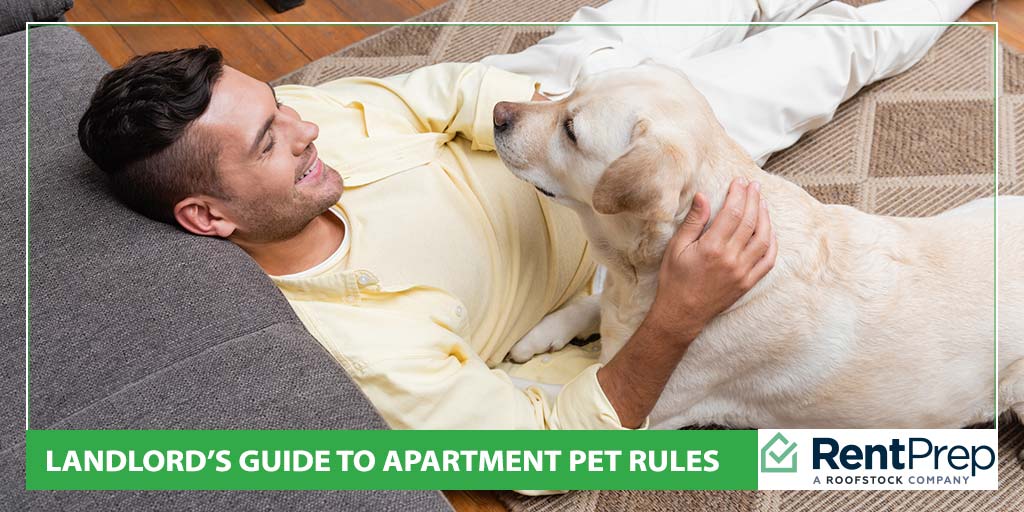
This article offers advice to landlords about creating rules and regulations for dogs as pets. When dogs are fulfilling the role of an assistant, service or companion dogs, there are completely different rules and regulations that apply. To learn more about dogs as service and companion animals, click here.
As a landlord, you have every right to decide whether you want your tenants to have dogs as pets on your rental property. There are as many different dog rules and regulations as there are landlords, so it’s difficult to state what is typical and what isn’t when it comes to the furry friends of prospective and current tenants. Dogs, in particular, seem to generate lots of strong feelings, both for and against. However, the one universal truth is that you must have a clear dog policy in place before you ever sign a lease agreement with your first tenant.
Dog regulations are some of the most controversial, and there are plenty of things that can go wrong. On the other hand, allowing dogs at your rental property can bring you a type of tenant that will be all the more eager to stay for a long time, because so many places don’t allow for dogs. If you can come up with some good rules and enforce them when it comes to dogs, you may be in the enviable position of having your choice of excellent applicants that you can entice to stay for many years.
Creating Apartment Pet Rules and Regulations
 Coming up with apartment pet rules and regulations for your property may seem easy, but it is actually complex if you want to do it right. It’s a good idea to sit down and decide what kind of things you DON’T want on your property, then reverse them in creating your policy. It’s the first step in creating or amending a pet agreement or addendum.
Coming up with apartment pet rules and regulations for your property may seem easy, but it is actually complex if you want to do it right. It’s a good idea to sit down and decide what kind of things you DON’T want on your property, then reverse them in creating your policy. It’s the first step in creating or amending a pet agreement or addendum.
For example, if you’re worst dog-related fears are multiple large, misbehaved creatures that tear up the property, bark all night long and leave “presents” everywhere, start with that. You can then create a list of regulations based on what you want to avoid. So, you might start your list with the following rules and regulations for dogs at your rental property:
- No more than two dogs per unit
- Only dogs under 20 pounds are allowed
- Applicants with dogs must show certification of completed behavior class
- You will charge the maximum pet deposit and pet fees allowed by your state (or whatever you feel would be sufficient that is less)
- Tenants with dogs get two warnings about noise violations before receiving a comply or quit notice
- Tenants will have dogs on a leash in all common areas
- Tenants will sign a pet/dog amendment to the lease agreement that outlines designated pet bathroom areas and cleanup requirements.
Of course, your own personal list of dog-related regulations will differ, especially if you are dealing with a single family rental property or a multi-unit building. However, the exercise remains valid no matter where you are located and what type of rental you have. This is a wonderful start to creating a clause in the lease agreement or a pet addendum to the lease that gives your tenants clear guidelines on your expectations for the property.
Less Common Considerations
It’s easy for landlords to think about noise and mess when it comes to dogs on the rental property, but there are several less common, but equally important, considerations. Here is a quick list of topics that you may want to consider adding to your lease agreement when it comes to allowing dogs.
Healthy dogs
You can request the most current shots record for any applicant or tenant’s dog to ensure that it is healthy, especially for rabies and other worrisome conditions.
Can a dog visit my apartment
Sometimes tenants will have visitors come to stay that also have dogs. Be clear about whether this is allowed in the first place, and if you will allow it, for how long. Make sure the tenant understands that all the same rules apply to the guest dog as they do to any permanent dogs.
Banned dogs
Some insurance companies will not include certain dog breeds in their coverage of a property, so check on whether that is true for you. If your insurance company has a list of banned breeds, that should be included in your official lease information.
Nuisance dogs
Just because dogs have a certificate from a behavior class doesn’t necessarily mean they will be well behaved. Make sure to clearly outline the steps of what happens if a dog becomes a nuisance or a danger, including biting someone on the property. Whether it’s a set of warnings or one strike and they are out, have it decided before it happens.
Offspring of dogs
Sometimes dog owners breed their dogs on purpose and sometimes dogs get pregnant without planning for it. Before a tenant comes to you with an armful of cute puppies, have a plan in place for how you and the tenant will deal with the situation.
Infested dogs
Dogs sometimes bring in pests, usually fleas. You can put the burden of pest control onto your tenant with a clearly worded clause that states they are responsible for the cost of eliminating pests.
Late addition dogs
If you allow dogs in your rental property, and the tenants don’t have one when they move in but later get one, it can lead to complications. Make sure you clearly state what you want to happen if tenants ever decide to acquire a dog, including paying a pet deposit and signing your pet addendum, and so forth.
Young dogs
It’s a fact that puppies have the potential to cause more damage than mature, trained dogs. Puppies don’t behave well in general, they chew a lot more and definitely will have problems with being potty trained. It’s entirely within your rights to restrict the age of the dogs that will be living in your rental property.
Landlords who have a clear dog policy in place before a tenant with a dog even moves in will not only reduce miscommunication and complaints, but they will also have the law on their side if it comes to enforcing the lease agreement. Trying to come up with rules and regulations after the lease is signed can become complicated and sometimes illegal.
Landlord Pet Policy

It’s very common for landlords to pull together a collection of vague dog rules and regulations, and then get frustrated when something happens with the dog and the property. So much of property management is reacting to an event that has already happened, and most landlords would agree that many of their rules and regulations have sprung from actual tenant problems. Dogs and their owners are no exception, and as you manage your property with dogs, there may be more unique issues that pop up.
Making changes or additions to dog regulations can be tricky, because changing just about anything in the rental property rules is likely to trigger complaints. The best way to approach making additions or changes to existing dog rules is to ask yourself if such a change violates the lease agreement that you and the tenant signed. If the new rule changes the lease agreement, then you really need to wait until the lease expires to do so. If the new rule is more of a housekeeping thing and won’t affect the tenant’s overall use or enjoyment of the property, you can implement it after written notification.
Here are just a few examples of changes that wouldn’t affect the lease agreement:
- Deciding that you want copies of shot records annually instead of upon application.
- Changing the designated “dog area” on a large property from one place to another.
- Adding an addendum about puppies and that they can only be on the property for a set time (like 7 weeks from birth).
- Almost any change that is more generous than your initial rules and regulations, such as allowing 2 dogs per unit instead of 1.
Here are a few examples of changes to the property dog rules that would most likely be against the existing lease agreement:
- Adding a no pets clause to the lease agreement.
- Going from allowing multiple dogs to only one dog per unit.
- Setting an allowed size of dog or adjusting that size after a dog is already living there.
- Starting the eviction process for the first dog-related noise violations when the previous policy was a 3 strikes method of enforcement.
- Charging a pet deposit or fee when there was none in the initial lease agreement.
In other words, don’t change the rules and regulations for dogs as outlined in the lease agreement if you are mid-lease with the tenant. You can legally change whatever you want as soon as the lease agreement expires. If you are in a month-to-month rental agreement with the tenant, you can give the tenant a 30-day written notice about the change in the rules and if they don’t comply, you can take the next steps.
Pet clause in lease agreement summary
Whether or not to allow dogs at your rental property is a big deal. Statistics show that nearly 55 million households in the United States own dogs, and nearly 66 percent consider dogs to be family members. Many highly qualified tenants won’t even call you to look at your vacant rental property if you don’t allow dogs. Also, it’s very common for people to agree to no dogs, then bring one in anyhow and hope you never notice. Then, you are stuck with an unmanaged dog and no pet security deposit to help cover costs form damage.
There are plenty of landlords who feel that since a large majority of tenants nowadays have dogs, yet the large majority of rental properties don’t allow them, that they can structure an arrangement that benefits them. If you are considering allowing dogs in your rental property, make sure you are very thorough with creating and enforcing your dog rules and regulations.

